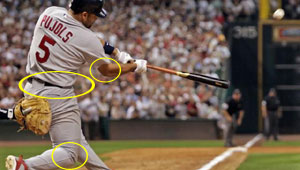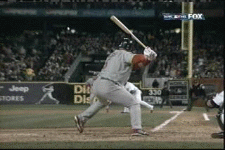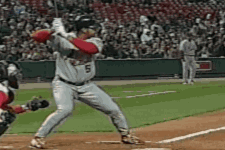Hips, Knees & Elbow in Baseball Swing

 Lets take a look at the correlation of the back elbow, back knee and back hip in the baseball swing. It’s my finding that the synchronization of these in the backside motion are critical to the success of a hitter. On the elite hitters in the game, such as Albert Pujols, these three separate parts of the body work in complete harmony. It is the ‘connected motion’ of the back hip, knee and elbow that drive the hands to the launch position. From “launch” ( which is basically at the point the hands catch up to the back hip once the back hip has rotated to the plate) the hands take over and attack the ball.
Lets take a look at the correlation of the back elbow, back knee and back hip in the baseball swing. It’s my finding that the synchronization of these in the backside motion are critical to the success of a hitter. On the elite hitters in the game, such as Albert Pujols, these three separate parts of the body work in complete harmony. It is the ‘connected motion’ of the back hip, knee and elbow that drive the hands to the launch position. From “launch” ( which is basically at the point the hands catch up to the back hip once the back hip has rotated to the plate) the hands take over and attack the ball.
You will notice that the bat barrel is considerably behind the hands and back hip at this point. This is called “bat lag” and is one of the keys to bat speed. The bat is literally poised for attack at the ball. Understand that the back hip and knee are larger body parts and move at a slower rate than do the hands. This is why they must get to the “launch” position much earlier than the hands reaches the hitting zone. As the ball reaches the hitting zone the hands then take over.
Notice also that once the hip and knee get turned to the point where the player’s belt buckle is facing the pitcher they are essentially done with their “part in the swing”. Pujols then begins to straighten the front side knee.. this counter motion action (another example of the “pushing and pulling” taking place in the swing) accelerates the speed of the hands allowing them to power the barrel into the zone. The weight and torque of the barrel going ahead of the hands then moves the swing into the extension and follow through stages of the swing. Basically, the hands finish the swing from that point. A fraction of a second before impact… and at impact… the hands are in the classic “top hand palm up, bottom hand palm down” position. They remain that way shortly through impact … and naturally roll due to the weight of the barrel passing them on their way to the finish. Something you should note: The barrel will “always” be below the ball and the hands will “always” be above the ball at impact. This is an absolute.
An athlete’s particular hand-eye coordination become the deciding factor on how well the barrel connects to the ball. His hand-eye coordination directly relate to the timing of the barrel through the hitting zone.
 It is no secret that the elite hitters are able to recognize and anticipate pitches… as a result of their personal experience with a particular pitcher… their numerous at-bats in like situations and pitch counts,etc. This “library of information” is based on a number of subconscious cues that they may pick up through micro seconds of information. Not to mention that they generally have the ability to review video files between at bats. What does all of this mean? First and foremost it assists in their timing by allowing them to rely on past performances and situations. In short, they can “look for” certain pitches. If you have a pretty good idea of what is coming it is likely that the ball will be hit very well.
It is no secret that the elite hitters are able to recognize and anticipate pitches… as a result of their personal experience with a particular pitcher… their numerous at-bats in like situations and pitch counts,etc. This “library of information” is based on a number of subconscious cues that they may pick up through micro seconds of information. Not to mention that they generally have the ability to review video files between at bats. What does all of this mean? First and foremost it assists in their timing by allowing them to rely on past performances and situations. In short, they can “look for” certain pitches. If you have a pretty good idea of what is coming it is likely that the ball will be hit very well.
Which brings me to this point: Build your swing! Make it mechanically sound. Take a look at these two frames again. They are of different at-bats… different games… different pitchers… different height of the pitch. But they are essentially the same swing! Mechanically sound. If that is in place, the player can simply concentrate on what the likely pitch is. To repeat… if you have a pretty good idea of what is coming it is likely that the ball will be hit very well!
If you consider that there are only 12 pitch counts and five of those are fastball counts (the other seven being neutral or off-speed), it shouldn’t be that difficult. For more on the pitch count and the importance it has on your success at the plate review the various articles throughout this website. Clearly it is a huge factor and one capitalized on by the elite hitters.
Of course, first they built a swing…Hips, Knees and Elbows… kinda funny how they have anything to do with the swing huh?
See the Six Steps to a Sweet Swing article to help in building the swing.
For help in developing a library of pitch probabilities based on pitch count – train with the XLR8 Speed Balls.

Not too sure about the sequence coming from the right side…I dont see it.